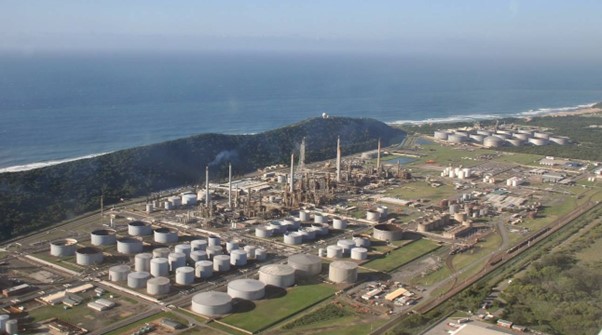Sapref oil refinery which has a nameplate capacity of 180 000 barrels per day and accounts for around 35% of the refinery capacity in South Africa was bought by the government.
Sapref the country’s largest refinery, was jointly owned by oil majors BP and Shell. The DMRE said in a statement the sale included the interest of Shell Downstream SA and bpSA in the Sapref land and other associated assets, including the crude and finished product tanks, process units, pipelines to and from Sapref to the Island View terminal, and the single buoy Mooring for crude imports. However, the sale excludes Sapref Ltd’s bpSA in the Sapref to the Island View terminal Operations, and the Lubricants blending and grease manufacturer, Blendcor (Pty) Ltd, DMRE said. Shell and bpSA’s CEO viewed the agreement as a positive outcome for the group and South Africa’s fuel industry. However, he emphasised that continued refinery ownership did not “fit” with bp’s global strategy. (moneyweb)
Under normal circumstances Sapref would have been left in private hands. The fact that the government is now buying up shares in this oil refinery from Shell and BP suggests they want to play a more dominant role in determining the oil price. An oil refinery is used usually to convert petroleum into gasoline, diesel fuel, asphalt base, and fuel oils etc. The purpose of this is to improve the quality of petroleum products for transport, cooking, heating, etc. It is interesting that the state is buying the refinery. South Africa it should be noted doesn’t produce any liquefied oil on its own. The country is mainly an importer of oil and heavily looking at other alternatives such as renewable energy to replace it. However, petroleum is used in other products such as plastic.
The Sapref refinery has paused operations since February 2022 when the two oil giants first considered a sale of the plant. Sapref has a nameplate capacity of 180 000 barrels per day and accounts around 35% of the refining capacity in South Africa. The DMRE said it has been concerned about South Africa’s declining oil refining capacity, which resulted in the country becoming a net importer of refined petroleum products. “This new emerging trend was not only threatening the country’s economic stability and security of supply of petroleum products, but also meant the exportation of jobs that are also needed in the country,” it noted. (Moneyweb)
It is clear that neither Shell nor BP were able to continue running the refinery, but the government needed to keep the facility open. Afterall to convert crude oil to usable fuels is no easy task. Sapref is the key to converting oil to gasoline and other forms of fuel in the province of KwZulu-Natal. Being so close to the major port of Durban means that it is key to having created jobs in the area. Industries are risking decline in South Africa and the government needs to look to Africa to gain the resources it wants. South Africa needs to look to Africa for new trading partners. This is especially true when it comes to oil. Nations such as Nigeria, South Sudan and Algeria produce significant quantities and South Africa needs to update its refineries to export from closer to home.
Meanwhile employment could also be generated by the construction of a new terminal in Durban.
South African entrepreneur and chairman of Mnambithi Group, Vusi Mazubuko, has described the signing of a terminal operating agreement with Transnet for the new 1.1 billion liquid bulk terminal at the port of Durban as a dream come true and landmark in his business journey. Speaking at the signing ceremony and sod-turning to launch the construction project at the port on Thursday Mazubuko, 68, said it had taken a decade of entrepreneurial tenacity and perseverance to get the project underway. “Today’s signing ceremony is a culmination of a journey that began about 10 years ago when I walked Transnet with a model of what I thought the terminal should look like,” Mazibuko said.(Mail and Guardian)
“That was the start of a very difficult journey. Our mission from the outset was to start with a strategy so that we could ship and store [liquid bulk cargo] and, if we ever wanted to make a success in the maritime industry, which was new to us, we had to cover the entire value chain,” he said. (Mail and Guardian)
So, Durban is now opening up about having a terminal for liquid storage. This means that jobs will be generated for this facility. When we talk about liquid bulk cargo, we are referring to oil, petroleum, fruit juices and rubber. So, oil will be a huge part of this. The construction of this terminal is meant to either hold liquified imports or exports. The new terminal will be state-of-art and take after the Fourth Industrial Revolution. The terminal serves the storage of imported as well as exported goods for Durban and the country as a whole. However, with renewable energy such as solar and wind on the rise it remains to be seen if oil or gasoline will be acceptable energy modes.
Plastic may still be around and will need to be made from oil. But to a lesser extent. Hazardous chemicals will also be held at the terminal possibly for both export and import use. The construction of such terminals and the purchasing of oil refineries are to ensure Durban and the country have a steady flow of petroleum as well as liquefied goods. Durban is strategically placed at the cross roads of the Indian Ocean for this.
Article written by:
Yacoob Cassim
Journalist at Radio Al Ansaar






